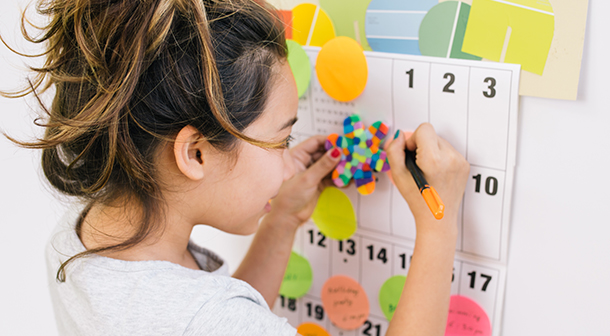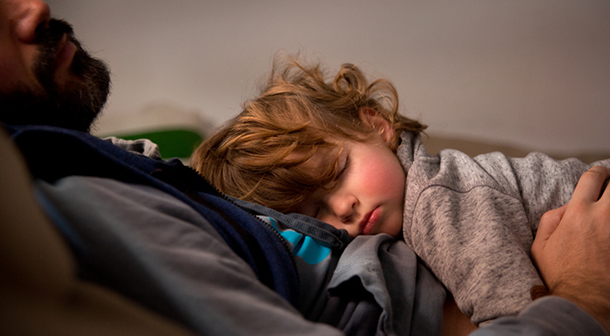When you have small children, making a family calendar can be the difference between sanity and chaos. Some parents like to plan every detail of each day when making a daily schedule. Others just like to make a general plan of who is responsible for what.
No matter how you make your family calendar, a plan can help things run more smoothly. Even if you're not able to stick to your plan all of the time, having guidelines can help you feel less overwhelmed and get more done. Family schedules and family rituals are also helpful for kids - knowing what to expect with a daily routine helps keep them healthy, happy, and out of trouble. Here are some tips for creating a family calendar that may work for your family.

Create a Daily Family Routine
Every child is different, and you know your child best. That's why you're the perfect person to put some guidelines in place for key family routines like bedtimes, meals, and naptimes. When your children are small, having a consistent daily schedule for kids helps them get enough rest and feel secure. Creating this daily family routine gives kids the structure they need to be healthy and happy.
Making sure children get enough sleep helps avoid the unpleasant tantrums that occur when little ones get too tired.
Sleeping Schedules for Kids
Sleep is a huge part of keeping young children healthy. Sleep plays a big role in a child's brain development and behavior, and many parents are surprised to learn how much sleep young children need. When kids don't get enough sleep, they can get cranky and have a harder time listening and following directions. A schedule can help kids get the sleep they need.
Get up around the same time every morning.
Start your family calendar with a consistent plan to get the day started. Many parents find when they get up a little earlier, it gives them more time to get things done around the house or get some work done before they need to get their children up. Of course, to make this happen, you'll need to make sure you set a consistent bedtime for yourself too.
Set a bedtime.
Children's brains get into routines. With a consistent and regular sleep time, your child's brain will start to wind down, making going to sleep easier. If bedtime is not consistent, your child's brain can't get into a rhythm, and falling asleep becomes more of a struggle. Did you know that when toddlers and young children don't get enough sleep, they actually have a harder time falling asleep? It's called being overtired. So how much sleep does your child need?
- Most toddlers need 12–14 hours of sleep each day.
- Preschool children need about 11–12 hours of sleep each day.
- School-age children need 10–11 hours of sleep each day.
Setting a Schedule
Plan for naps.
A child's need for sleep varies by age and child, but most young children get a lot of benefit from an afternoon nap. On the other hand, don't let naptime become a fight. If your kids want to skip the afternoon nap, encourage them to look at books or read them a story. They might fall asleep! Even if naptime turns into quiet time, children still benefit from a break in their day.
Here's a general guide for napping:
- Most toddlers need an afternoon nap of 1–3 hours. Young toddlers might need a morning nap, too.
- Preschoolers also benefit from an afternoon nap. Most children stop napping around age 5.
- Some school-age children may need an earlier bedtime if they can't take an afternoon nap because of kindergarten.
When kids stop napping, they may need an earlier bedtime!

Make Meals a Family Routine
Most young children need 3 meals and 2–3 healthy snacks each day.
Make mealtimes consistent.
Try to serve your child meals and snacks around the same times every day. Discourage kids from snacking at other times, and don't let them fill up on drinks like milk or juice.
Make mealtimes special.
When it's possible, eat meals together as a family, and sit at a table so everyone can focus on their food. Put your phones away and turn off the television for some uninterrupted family time. If everyone is part of the routine, the child will see this as something everyone does.
Let your child help.
Children are much more likely to try new foods when they can help pick them out and prepare them. Let your child go to the grocery store with you and pick out a new food to try together. Young children can help wash fruits and veggies, wipe down tables, stir batter, and add ingredients.
Don't make mealtimes a battle.
Sometimes kids eat a lot, sometimes they seem to eat nothing. If they are growing, then they are likely getting enough nutrition. Continue offering kids enough healthy food to get full during mealtimes. Children know and will be able to tell you when they're full and have had enough. Try introducing your kids to new foods without forcing them. Introducing new foods along with foods they like makes trying new ones less scary. Some kids need to see new a food multiple times before they are ready to try it, so don't give up!
Need parenting help now?
The Texas Parent Helpline is available 24/7.
- Call 833-680-0611
- Chat with us
- Text 833-680-0611

Make a Weekly Family Schedule
Once you've got an idea of what your daily routine will be like, think about the bigger picture. Prioritize what your family needs to get done in the next week. What things must get done? What would you like to get done?
Make a plan.
Take 30 minutes at the start of every week to sit down and decide what needs to be done, who will do it, and when. Include all the people who help care for your child. Think about planning family meals, household chores, laundry, work time, and other necessities like doctors' appointments.
Write it down.
Write down your family schedule on a calendar that you keep in a central place, or use a shared-calendar app to create a family calendar that everyone can see on their computer or phone. Shared apps are nice because everyone can pull up the calendar anytime, see what they need to do, and make edits. These family calendars can also send digital reminders to help you stay on track.
Don't forget the fun stuff.
Include some fun activities and family rituals on your family calendar. Maybe Wednesday night is Pizza Night, or Saturday afternoons are for family walks - whatever your family likes to do together. These consistent activities make great memories for your children!
Don't forget to exercise.
Getting out and being active is good for both parents and kids, and it's a fun thing you can do together. When children have daily active play, they sleep better and feel better. Go for a walk, have a dance party in the living room, play with balls, go to a park, or walk the dog! Starting regular exercise habits when your kids are young sets them up for a lifetime of healthier living.
Check in throughout the week.
Take a few minutes every day, either at night before bed or in the morning before the kids wake up, to go over the plan for the next day. Be sure everyone knows their daily tasks.
Be flexible and ask for help when you need it.
All parents need help sometimes. If something comes up, like needing to pick up a sick child during the day or getting delayed at work, and it keeps you from sticking to your set routine, it's OK. Ask a family member or friend for help to keep you as close to your routine as possible and be sure to do the same for your friend. Remember, you will have time tomorrow morning to adjust your schedule to achieve anything you were not able to get to today!
Download a printable Family Schedule.
Consistency is Key
Just as you try to be consistent with family rules and consequences, do your best to be consistent with your family schedule. Children thrive when they have a reliable family routine. As much as you can, plan activities, meals, naptimes, and bedtimes to help avoid meltdowns. While it might sometimes seem like you're missing out, remember that kids grow up fast and this is temporary.
When the Family Routine Gets Off
As much as you plan ahead, there will be times when you can't stay on schedule. You might have to wait at an appointment longer than expected, or your child might miss a nap or stay up past bedtime.
Do your best to roll with the unexpected, knowing you'll get back to your family schedule as soon as you can. Know that making a plan is an important step, and your hard work will pay off in the long run.
At places like doctors' waiting rooms or when standing in line, there's often nothing to do but wait. Bring along small activities for your kids, like crayons and paper. It's also a good idea to tuck some healthy snacks in your bag. Waiting time can mean quality time and a chance to put the cell phones away.
For More Information
- Download and print Enjoy Time Together at Home, a helpful tip sheet from our parenting resources.





